The Lockheed P-38 Lightning was a heavy fighter aircraft designed to meet specification X-608, spearheaded by Ly Benjamin Kelsey,[1] for a high altitude interceptor capable of reaching 579 km/h at 6,000 metres – with an endurance of one hour at that height – and 466.7 km/h at sea level, with the ability to take off and land over a fifteen-meter obstacle within 675 metres,[2] issued in February 1937.[3]
Description[]
The P-38D Lightning, the first production model had the standard twin Allison V-1710-27 Engines mounted with a rear tail boom type arrangement. However, the main distinction this model had over earlier prototype examples was its added armor protection to the cockpit, self-sealing fuel tanks, and a redesigned rear section for greater stability. Its empty weight was around 5,343 kilograms with a total length of eleven meters and wingspan of fifteen meters.[4]
The standard armament of the P-38 was one 37mm autocannon and four 12.7mm Browning M2 machine guns. Operational range of the aircraft meanwhile was around 1,576 kilometers with a service ceiling set at 11,887 metres. While the P-38D was issued to some units, the P-38D was more of a pre-production model given the fact that a mere thirty-six examples were produced. Most notable for early production P-38s, the P-38D being one was that the cockpit was often regarded as quite uncomfortable with frostbite being a serious threat in high altitude operations.
Variants[]
The P-38 was one series of aircraft that had numerous other variants produced to meet the needs of an ever-changing war. The first of these was the P-38E which had its 37mm autocannon removed in favor of a single Hispano-Suiza HS.404 Autocannon. While not being quite as strong as its 37mm counterpart, the 20mm was still a formidible weapon and especially in the pacific, very few aircraft could withstand a direct burst of fire from the combined arms of the P-38's frontal armament.
Besides the armament change, the P-38E was fundamentallly the same as its predecessor. The P-38F meanwhile was a variant that was designed to service in the Pacific Theater and thus was given the reliable Allison V-1710-49 engine with a new top speed of 635 kilometers per hour at around 7,600 meters and 558 kilometers per hour at 1,500 meters. Furthermore, the P-38F had the capability to fit up to 900 kilograms worth of bombs in underwing racks. The added strongpoints could also allow for drop tanks.
Also produced was the F-38G Lightning which was similar to the P-38F except for Allison V-1710-55 engines for improved performance. However, this model was dropped in favor of the P-38G which was able to carry a far superior load of 1,814 kilograms. It also had Allison V-1710-89 engines to assist it in carrying this new load. The P-38G was first put into service with frontline units in mid 1942.

A P-38, nicknamed 'Pudgy' operating in the Pacific
Following it would be the P-38H which was supposed to have improved performance, especially range but suffered mechanical issues. As such, only 600 examples were produced before production stopped. Following it however would be the P-38J. This model was largely improved with bulletproofing added to the windscreen, more fuel added for a larger operational range, and much improved engine performance. Initially, the P-38J model utilized the previous Allison engines though had them largely improved with modified cooling systems and a redesigned engine shape for better aerodynamics. Furthermore, the turbo charger was also modified, allowing for better climbing. A sub-variant of the P-38J, the P-38J-25 had dive brakes attached for better ground attack capabilities. Some P-38Js were also converted to have clear nose sections for bombardiers to aim and mark targets. A similar system was implemented in numerous P-38Ls which had the capability to mount underwing rockets and bombs.
The final variants of the P-38 series are the P-38M, a night fighting variant equipped with a second crew seat and radar as well as the F-5 Lighting which was a pathfinder/reconnaissance type aircraft.[5] A similar variant was designated the F-4 which was based upon the earlier P-38E and equipped with four K17 model cameras.
Experimental[]
A single P-38J-1-LO, s/n 42-13565, was fitted with 54 thermocouples located at various points throughout the airframe, for cold weather testing at Ladd Air Base, Fairbanks, Alaska during the winter of 1943-1944. During March 1944, 13565 was fitted with retractable skis in place of the wheels, and used by Randy Acord for 165 landings. During this period, 13565's right engine used the first synthetic oil ever flown, supplied from a 165-gallon belly tank on the right (starboard) side of the aircraft.[N 1]
History[]
Development[]
An official contract was issued in June 1937 for one prototype of the Lockheed Model 322 as the XP-38, powered by Allison V-1710 11/15 engines developing 960 bhp at 12,000 ft and 1,090 bhp at 13,200 ft, driving inwardly rotating Curtiss Electric airscrews to combat torque. Realising that no single engine available at the time was capable of giving sufficient power to meet the specification, H.L. Hubbard’s design team designed a twin boom machine powered by two Alison V-1710 engines.[N 2] The booms provided convenient mountings for the engines, turbo superchargers, radiator baths and main undercarriage wheels, while offering the possibility of installing the gun armament - one 23mm Marsden cannon with 50 rounds and four 0.5in (12.7mm) M2 colt Browning machine guns with 1,000 rounds each - in a central nacelle. In addition, the twin tail assembly increased the effective tailplane aspect ratio, providing stability over a large centre of gravity range.[2]

An F-5 Reconnaissance Lightning with D-Day Invasion stripes flying over France, 1944
Late at night on December 31, 1938 the completed XP-38, which weighed 18,600 kilograms, was stripped down, covered with canvas and loaded onto three trucks, before being transferred – under great secrecy and with police escort – to March Field, Riverside, to allow Lt B. S. Kelsey to begin flight tests. However, the first ground run ended with the XP-38 in a ditch due to brake failure.
Despite this, The XP-39 completed it’s first flight on 27 January 1939, before making a cross country flight from March Field, California to Mitchell Field, New York on 11 February. The flight was completed in 7 hours and 2 minutes, including two refuelling stops, ending with the total loss of the prototype when it undershot on approach.[2] Following the loss of the XP-38, a Limited Procurement Order was issued for thirteen YP-38s for service evaluation, with the first reaching the Army in March 1941. These aircraft had Allison V-1710-27/29 engines producing 1,150 hp, driving outwardly rotating propellers. They carried one 37mm cannon, two 0.5in MG-53 machine guns and two 0.3in MG-40 machine guns, and weighed 14,348 lb – which due to structural redesign was less than the XP-38.[2]
The P-38D Lightning was also ordered - and subsequently rejected - by Great Britain as the Model 322-B,[1] to be designated Mk I (AE978-AF220) or Mk II (AF221-AF744).[7] The turbo chargers were removed, and the counter rotating ‘handed’ propellers were replaced with standard units, either because of an export prohibition imposed on these items by the US State Department[2] or at the request of the British,[3] only for these examples to be quickly rejected by the British for underperforming, though this was most likely because of the lack of superchargers.[N 3]
Despite this, a single P-38J, serial 44-23517, served operationally with RAF Bomber Command during the later war years. Initially acquired for the personal use of Air Commodore Alfred Sharp, in exchange for a Republic P-47 Thunderbolt following his appointment as commander of 5 Group Bomber Command in mid 1944, 44-23517 was used by Squadron Leader Owen during bombing attacks against French targets during the first week of August 1944. Subsequently fitted with a glazed nose and new navigation aids, and painted PRU Blue with RAF Markings, the aircraft was used by Owen for target marking and bomber control missions, before being taken to Northolt by Sharp upon his posting to the staff of Tiger Force. Sharp retained the aircraft, now bearing the letters DPA, when he took up an appointment at the Air Ministry, until it was flown to 51 MU at lichfield for disposal. Still wearing it's RAF colours, it was eventually returned to the United States.[8]
Combat Service[]
The P-38F-4 was the first model in the series to see combat service during World War II. This reconnaissance aircraft originally operated out of Australia. However, P-38Es were likewise issued a month or two later in the Aleutian Island campaign where they scored the first Japanese kill of the series by downing a Kawanishi H6K. However, the severe weather took a toll on the aircraft and numerous were lost to accident or crash, many more than actual enemy action. Furthermore, the first American kill of the war occurred in a P-38E operating out of Iceland which on December 7, 1941 shot down a Focke Wulf Fw 200 patrol aircraft.

Typical P-38E in flight
It wasn't until 1943 that the P-38 began operating in Europe against German and Italian forces. Critically, the P-38 was the only allied fighter aircraft with the range to escort bombing raids over Germany. As the war raged, the P-38 went on to claim the most Japanese kills in whole Pacific Theater, overtaking contemporary designs such as the Supermarine Seafire, F6F Hellcat, and F4U Corsair. One of the reasons the P-38 was so effective was its long range which allowed it to operate from the various small outposts and islands of the pacific. Notably, a flight of P-38s were responsible for the death of Isoroku Yamamoto in 1943 when they shot down his Mitsubishi G4M. However, in the European Theater, the P-38 was overtaken by the P-51, P-47, and Spitfire in its escort duties. Though it was not phased out completely, instead being used typically in the ground attack role for which it was well suited. In the reconnaissance role, it was especially noted by American commanders such as Jimmy Doolittle that the P-38 was hard to confuse for enemy aircraft, thus was more ideal for surveying the battlefield without being attacked by friendly forces.
In total, around 10,000 P-38s had been made during the war and continued to be produced after the war. However, most were phased out quickly with others being sold off to other countries.
Notes[]
- ↑ This configuration left some of the Russian pilots based at Ladd wondering how the P-38 was able to fly with so much weight on one side.[6]
- ↑ This design, which was initially known as the Model 022, was identified in project documents from March 1936 as Project M-12-36.[1]
- ↑ The second explanation is more likely, as the French had also requested that no turbo-superchargers or handed propellers be fitted to the 417 Model 322-Fs they ordered in May 1940.[1]
References[]
- ↑ 1.0 1.1 1.2 1.3 Aeroplane Monthly - October 2004 Reference Database: P-38 Lighting, (2004)
- ↑ 2.0 2.1 2.2 2.3 2.4 Green, William. Famous Fighters of the Second World War. Purnell Book Services. (1975)
- ↑ 3.0 3.1 Gunston, Bill. St Michael Aircraft of World War 2. Octopus Books. (1982)
- ↑ http://www.wwiivehicles.com/usa/aircraft/fighter/lockheed-p-38d-lightning.asp
- ↑ http://www.militaryfactory.com/aircraft/detail.asp?aircraft_id=74
- ↑ Interview with Randy Acord, Project Officer for the Cold Weather Test Detachment - Fly Past (October 1989) Page 67
- ↑ Robertson, Bruce. British Military Aircraft Serials 1912-1966. Ian Allen Ltd. (1967)
- ↑ Fly Past June 2015 Page 90 via Andrew Thomas.
| ||||||||||||||
